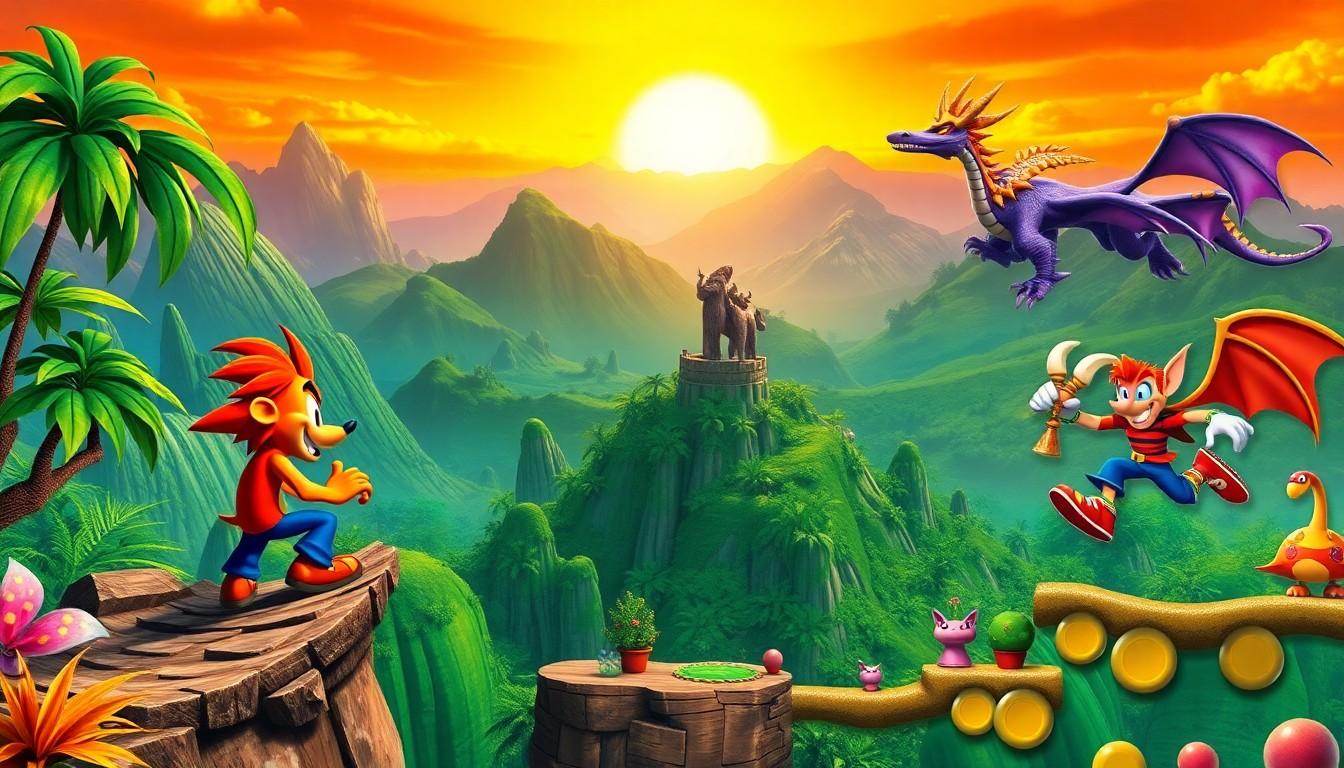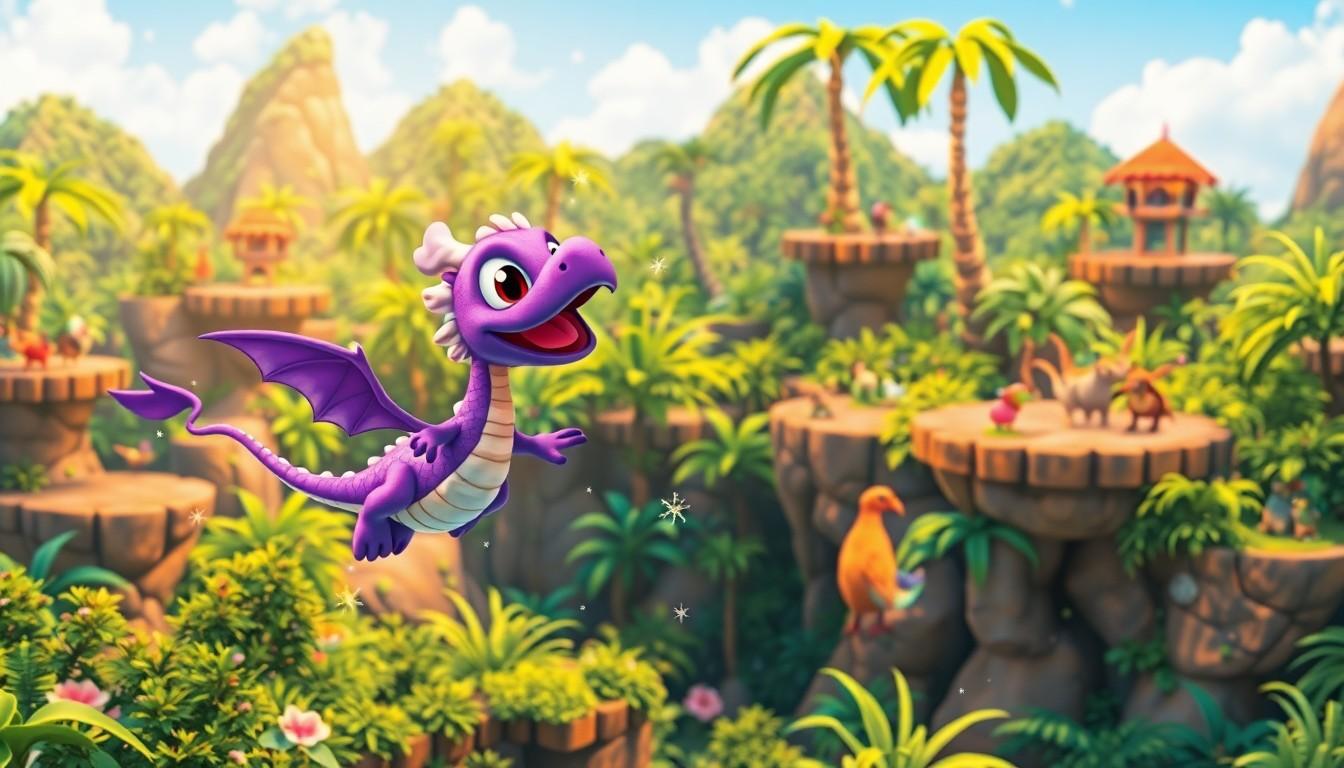In the late ’90s, the PlayStation 1 revolutionized gaming, bringing a wave of platformers that had players jumping for joy—literally. From colorful worlds filled with quirky characters to challenging levels that tested reflexes and patience, these games defined an era. Who could forget the thrill of guiding a fuzzy creature through a pixelated paradise or the satisfaction of collecting every last gem?
These PS1 platformers didn’t just offer escapism; they served up a hearty dose of nostalgia that still resonates today. Whether you were a seasoned gamer or a curious newcomer, these titles had a way of making players feel like heroes in their own epic tales. So grab your controller and get ready to leap back into a world where every jump matters and adventure is just a save point away.
ps1 platformers
PlayStation 1 platformers reshaped the gaming landscape in the late ’90s. They featured vibrant graphics and innovative gameplay that appealed to diverse audiences. Iconic titles like “Crash Bandicoot” and “Spyro the Dragon” became synonymous with the genre. These games introduced characters with distinct personalities and unique abilities, enhancing player engagement.
Level designs varied, ranging from lush jungles to treacherous mountains. Unique gameplay mechanics kept players coming back for more. Collecting items, mastering jumps, and defeating enemies provided rewarding experiences. Each title offered a blend of challenge and enjoyment, making gameplay memorable.
Nostalgia drives the appeal of these classics. Many gamers fondly remember their childhoods spent conquering challenging levels. Retro gaming has surged in popularity, with many revisiting these titles on modern consoles. They’re often credited with laying the groundwork for future platformers.
The impact of PS1 platformers extends beyond mere entertainment. They introduced storytelling elements that enriched the gaming experience. Emotional narratives paired with colorful worlds resonated with players, creating lasting impressions. As technology advanced, these titles influenced game design principles in subsequent generations.
Today, developers draw inspiration from PS1 platformers. Classic gameplay elements find their way into modern games, keeping the essence alive. Remastered versions and sequels showcase the timelessness of these beloved titles. A resurgence in interest ensures that the legacy of PS1 platformers continues to thrive, captivating new audiences with every leap and bound.
Iconic PS1 Platformer Titles

PlayStation 1 platformers left a significant mark on gaming history. Several iconic titles defined the genre and captivated players.
Crash Bandicoot Series
Crash Bandicoot embodies the spirit of adventure, featuring vibrant worlds and challenging levels. Players control Crash, a lovable character, navigating through jungles, beaches, and volcanoes. The series introduced unique gameplay mechanics, such as spinning and jumping on enemies. Collecting Wumpa fruits and defeating Dr. Neo Cortex added layers to the excitement. Released in 1996, this franchise became a cornerstone of PS1 gaming, praised for its engaging platforming and cooperative multiplayer modes, allowing friends to join Crash on his journeys.
Spyro the Dragon Series
Spyro the Dragon transports players into a colorful fantasy realm filled with dragons and magical creatures. Players guide Spyro, using fire breath and gliding abilities to explore various worlds. Released in 1998, this series introduced unique level designs where players collect gems and free captured dragons. Each world presented distinct challenges, keeping gameplay fresh and entertaining. Spyro’s charming personality and whimsical environments established it as a beloved title, appealing to players seeking adventure and exploration.
Rayman
Rayman offers a whimsical platforming experience, diverging from traditional characters and gameplay. Players control Rayman, a heroic figure tackling imaginative worlds filled with quirky enemies. Released in 1995, it featured innovative graphics and inventive level designs that captivated audiences. Players appreciate the game’s emphasis on timing and precision, requiring careful navigation. Rayman’s unique charm and artistic style contributed to its standout status among PS1 platformers.
Gameplay Mechanics
Gameplay mechanics in PS1 platformers significantly shaped player experiences, fueling both exploration and skill mastery. These elements combined creativity with challenge, providing memorable adventures.
Level Design
Level design in PS1 platformers features vibrant visuals and intricate layouts that invite exploration. Each level often incorporates unique themes, such as jungles, castles, and fantasy realms. Players encounter various obstacles and enemies, ensuring dynamic gameplay and strategic navigation. Secrets like hidden paths and collectible items reward curiosity and skill. Iconic games like “Crash Bandicoot” excel in this aspect, presenting levels that increase in difficulty, fostering a sense of accomplishment as players progress. “Spyro the Dragon” enhances enjoyment with open-world designs that encourage players to glide and explore diverse environments.
Character Controls
Character controls define the user experience in PS1 platformers, balancing precision and responsiveness. Players rely on intuitive controls to navigate challenging terrain and execute special abilities. In “Crash Bandicoot,” players perform jumps and spins with ease, making intricate platforming sequences accessible. “Spyro” allows players to explore with gliding and fire-breathing, requiring coordination and timing. Control responsiveness enhances immersion, ensuring players fully engage with the game world. Modern successors maintain these control principles, illustrating their lasting impact on gameplay mechanics.
Visual and Audio Elements
PS1 platformers are renowned for their vibrant graphics and immersive audio, which contributed significantly to the gaming experience.
Graphics and Art Style
Developers leveraged the PlayStation’s capabilities to craft unique visuals. Each title boasted colorful landscapes that enhanced the exploration aspect. The “Crash Bandicoot” series featured lush environments filled with detailed backgrounds. Similarly, “Spyro the Dragon” utilized a whimsical art style that transported players to a fantastical realm. Character designs were equally memorable, with each protagonist showcasing distinct traits. Bright colors and imaginative worlds made these games visually appealing, engaging players’ senses while guiding them through intricate level designs. Players often revelled in the artistic creativity that defined the PS1 platformer genre.
Soundtrack and Sound Effects
Audio elements played a crucial role in enhancing gameplay. Memorable soundtracks complemented the action perfectly, evoking nostalgia. The “Crash Bandicoot” series featured catchy tunes that energized players during gameplay. Sound effects added an extra layer of immersion, with distinct sounds for jumps, collectables, and enemy interactions. “Spyro the Dragon” excelled in creating atmospheric music that reflected the mood of each level. Engaging sound design not only enriched the experience but also contributed to the emotional connection players had with characters. Overall, the audio landscape transformed simple platform challenges into unforgettable adventures.
Legacy of PS1 Platformers
PlayStation 1 platformers left a significant mark on the gaming industry. Their innovative designs and captivating gameplay shaped future titles and genres.
Influence on Future Games
PS1 platformers influenced game development trends, inspiring a generation of designers. Mechanics such as tight controls and intricate level designs became staples in later platformers. Successors like “Ratchet & Clank” and “Sonic Adventure” borrowed elements from iconic titles. Games began to incorporate storytelling and emotional depth, reflecting the narrative styles of classics like “Spyro the Dragon.” Enhanced graphics technology further propelled creativity, allowing for imaginative worlds inspired by PS1 masterpieces. Developers continue to revisit these concepts, ensuring platformers remain engaging and relevant today.
Nostalgia and Collectibility
Nostalgia fuels the demand for PS1 platformers among gamers. Many enthusiasts cherish their childhood experiences with titles like “Crash Bandicoot.” Re-releases and remastered versions attract new players, highlighting the lasting appeal of these games. Collectible editions and nostalgic merchandise celebrate the enduring legacy, connecting generations of gamers. Online communities foster discussions and share tips, creating a communal atmosphere. The resurgence of retro gaming proves that these classic platformers resonate, enriching the gaming landscape with beloved memories.
The legacy of PS1 platformers continues to resonate with gamers of all ages. These titles not only defined a generation but also set the standard for future games with their innovative mechanics and captivating worlds. Nostalgia plays a significant role in their enduring popularity as players revisit cherished memories while introducing new audiences to these classics.
As retro gaming thrives, the influence of PS1 platformers remains evident in modern titles that draw inspiration from their design and gameplay elements. The vibrant graphics and engaging soundtracks of these games have left an indelible mark on the industry, ensuring they’ll be remembered and celebrated for years to come.

